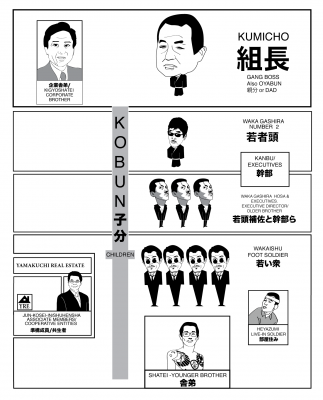
Illustration by Mari Kurisato
(親分・おやぶん), (子分・こぶん): group elders, group underlings. Literally, ‘father role’ and ‘child role’.
(組長・くみちょう): family head or boss
(最高幹部・さいこうかんぶ): senior executives
(組員・くみいん): group members, often translated as ‘soldiers’
(周辺者・しゅうへんしゃ): peripheral associates
(企業舎弟・きぎょうしゃてい): business associates
(組・ぐみ): Denotes association, as in, Yamaguchi-gumi (山口組). Similar to -kai.
(一家・いっか): family. For example, Omaeda-ikka (小前田一家), or ‘Omaeda family’. Used as a suffix after the name of the group.
(会・かい): Denotes association, as in, Sumiyoshi-kai (住吉会). Used to describe parent organizations.
(若頭・わかがしら): Gang members who rank second behind a kumicho. The gang equivalent of eldest brother. お兄ちゃん。
(若衆・わかしゅう): Used as an umbrella term to indicate gang members who have completed the sakazuki ceremony to join an organisation, but are still ranked below wakagashira. Foot-soldiers. 兵補 (へいほ)
I’ve always loved stories about gangsters western-ways of course, but my like for japan took deeper and deeper into the country’s most regretable stuff.
Thanks Mr Adelstain for this info, is very well gathered and explained, and also, it helps my Hiragana understanding as my Japanese language course progresses.
I’m glad it helped!
Jake:
Love this site – very informative! Questions: who are “chimpira” and where do they rank in this hierarchy? Is this term used amongst other yakuza, and is it considered derogatory?
Chinpira are basically low-ranking yakuza who are rather unintelligent and often don’t uphold the institutional rules: no theft, no robbery (mugging), no sexual crimes, no dealing in drugs.
[…] http://www.japansubculture.com/resources/yakuza-group-structure/ […]
Jake, I really appreicate this site and what you post, I also am really enjoying Tokyo Vice. Do you facebook? I message you off line…
Great work…
You’re welcome. No, I don’t Facebook these days. I’m on twitter.
What do you think about the books by Miyazaki Manabu? Toppamono (part 1) has been translated in English and after reading it, I felt it was an interesting learning experience. My question is whether someone like Mr. Miyazaki is generally considered yakuza or not? And if he’s not, then where would you rank him within Japan’s underworld, if at all? Thanks.
Mizyaki Manabu is an apologist for the yakuza and I believe that his father was in the yakuza but am not sure. He would be considered an associate. I met him once outside the courtroom for the trial of Tadamasa Goto on real estate related fraud.
Interesting stuff…I’ve been reading most of your articles about this Japanese Mafia group…the organistional structure just gives me a fair image of how they operate..thanks again!!!
I’m glad it’s useful. I’ve always hoped that this website would be used for research by those interested in the Japanese underworld.
Finished Tokyo Vice today and I must say it’s the best true crime type book I have read by a reporter. Normally I don’t care for books written about crime by reporters but Tokyo Vice was a whole other ball game.
I still don’t fully grasp the true structure of a yakuza family. In all the diagrams I’ve seen it looks very clear and linier like an Italian organization but upon further inspection it seems far more complex. For example in Tokyo Vice the Goto-gumi is a faction of Yamaguchi-gumi so the head of Goto-gumi answers to a higher up? Is it just one higher up or is there a whole organization above him? You mentioned at the end that someone very high up called you but the way you said it eludes that there may yet be someone above him. is there one clear leader of the whole syndicate?
Also I don’t know if this is the place to ask this but, did you ever get any more information about “Helena”?
Goto-gumi was a second tier group in the Yamaguchi-gumi. In other words, Goto Tadamasa was a 直参 (jiki-san), one of the core representative in the Yamaguchi-gumi itself and part of the ruling council. He had to answer to many people higher than himself.
As for Helena, nothing solid.
I loved reading Tokyo Vice and have followed your investigation into Tadamasa Goto and the Lucie Blackman case. I am most interested in “old” yakuza from the period of 1900 to 1925 particularly, their criminal activities in Yokohama and their involvment (and evolution) in the aftermath of the Great Kanto earthquake of 1923. I was wondering if you would suggest some reading material (English language) for me to pursue. I have read Confessions of a Yakuza by Junichi Saga which I found very helpful and Yokohama Burning but have not had much luck finding more material relative to the yakuza in this time period. Will you help me? Im on Twitter @DesireeAHung if you want to reach me.
Thank you.
There is a book in Japanese called 病理集団の構造 which is useful in studying the old school yakuza. If you read Japanese, I can probably recommend some other books.
I do not speak Japanese. Is there a translation?
Thank you for your reply. It was most appreciated!
Ditka suggesting that football is superior to Farmacia On Line.
So dont delay and choose an affordable wedding paphos car hire for your international vacation,
make some arrangements ahead of time.
(sorry about my english.My name is Carlos Eduardo, i speak from Brasil.)Great job you have done mr. Jake Aldestein.I fishined to read your book today, and i needed do leave this message to you.You have my respect.Congratulations.Like we use to say here in Brasil : Um forte abraço!
Carlos-sama!
Thank you very much for writing and for earning your respect. I will try to live up to it.
Very energetic blog, I loved that bit. Will there be a part
2?
My site … szybka pozyczka internetowa
hi guys i want this job because ilove it